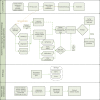How the provenance of electronic health record data matters for research: a case example using system mapping
- PMID: 25821838
- PMCID: PMC4371416
- DOI: 10.13063/2327-9214.1058
How the provenance of electronic health record data matters for research: a case example using system mapping
Abstract
Introduction: The use of electronic health records (EHRs) for research is proceeding rapidly, driven by computational power, analytical techniques, and policy. However, EHR-based research is limited by the complexity of EHR data and a lack of understanding about data provenance, meaning the context under which the data were collected. This paper presents system flow mapping as a method to help researchers more fully understand the provenance of their EHR data as it relates to local workflow. We provide two specific examples of how this method can improve data identification, documentation, and processing.
Background: EHRs store clinical and administrative data, often in unstructured fields. Each clinical system has a unique and dynamic workflow, as well as an EHR customized for local use. The EHR customization may be influenced by a broader context such as documentation required for billing.
Methods: We present a case study with two examples of using system flow mapping to characterize EHR data for a local colorectal cancer screening process.
Findings: System flow mapping demonstrated that information entered into the EHR during clinical practice required interpretation and transformation before it could be accurately applied to research. We illustrate how system flow mapping shaped our knowledge of the quality and completeness of data in two examples: (1) determining colonoscopy indication as recorded in the EHR, and (2) discovering a specific EHR form that captured family history.
Discussion: Researchers who do not consider data provenance risk compiling data that are systematically incomplete or incorrect. For example, researchers who are not familiar with the clinical workflow under which data were entered might miss or misunderstand patient information or procedure and diagnostic codes.
Conclusions: Data provenance is a fundamental characteristic of research data from EHRs. Given the diversity of EHR platforms and system workflows, researchers need tools for evaluating and reporting data availability, quality, and transformations. Our case study illustrates how system mapping can inform researchers about the provenance of their data as it pertains to local workflows.
Keywords: Context; Data Use and Quality; Health Information Technology.
Figures
Similar articles
-
Assessing the Availability of Data on Social and Behavioral Determinants in Structured and Unstructured Electronic Health Records: A Retrospective Analysis of a Multilevel Health Care System.JMIR Med Inform. 2019 Aug 2;7(3):e13802. doi: 10.2196/13802. JMIR Med Inform. 2019. PMID: 31376277 Free PMC article.
-
Modifying the electronic health record to facilitate the implementation and evaluation of a bundled care program for intensive care unit delirium.EGEMS (Wash DC). 2014 Dec 18;2(1):1121. doi: 10.13063/2327-9214.1121. eCollection 2014. EGEMS (Wash DC). 2014. PMID: 25848599 Free PMC article.
-
Mapping communication spaces: The development and use of a tool for analyzing the impact of EHRs on interprofessional collaborative practice.Int J Med Inform. 2016 Sep;93:2-13. doi: 10.1016/j.ijmedinf.2016.05.003. Epub 2016 May 20. Int J Med Inform. 2016. PMID: 27435942
-
Comparison of electronic health record system functionalities to support the patient recruitment process in clinical trials.Int J Med Inform. 2014 Nov;83(11):860-8. doi: 10.1016/j.ijmedinf.2014.08.005. Epub 2014 Aug 25. Int J Med Inform. 2014. PMID: 25189709 Review.
-
Methods and dimensions of electronic health record data quality assessment: enabling reuse for clinical research.J Am Med Inform Assoc. 2013 Jan 1;20(1):144-51. doi: 10.1136/amiajnl-2011-000681. Epub 2012 Jun 25. J Am Med Inform Assoc. 2013. PMID: 22733976 Free PMC article. Review.
Cited by
-
A roadmap to artificial intelligence (AI): Methods for designing and building AI ready data to promote fairness.J Biomed Inform. 2024 Jun;154:104654. doi: 10.1016/j.jbi.2024.104654. Epub 2024 May 11. J Biomed Inform. 2024. PMID: 38740316 Free PMC article.
-
Diagnosis, misdiagnosis, lucky guess, hearsay, and more: an ontological analysis.J Biomed Semantics. 2016 Sep 15;7(1):54. doi: 10.1186/s13326-016-0098-5. J Biomed Semantics. 2016. PMID: 27633888 Free PMC article.
-
Extracting Electronic Health Record Data in a Practice-Based Research Network: Processes to Support Translational Research across Diverse Practice Organizations.EGEMS (Wash DC). 2016 Mar 29;4(2):1206. doi: 10.13063/2327-9214.1206. eCollection 2016. EGEMS (Wash DC). 2016. PMID: 27141519 Free PMC article.
-
Embedded research to improve health: the 20th annual HMO Research Network conference, March 31-April 3, 2014, Phoenix, Arizona.Clin Med Res. 2014 Sep;12(1-2):73-6. doi: 10.3121/cmr.2014.1251. Clin Med Res. 2014. PMID: 25352609 Free PMC article. No abstract available.
-
Approaches and Criteria for Provenance in Biomedical Data Sets and Workflows: Protocol for a Scoping Review.JMIR Res Protoc. 2021 Nov 22;10(11):e31750. doi: 10.2196/31750. JMIR Res Protoc. 2021. PMID: 34813494 Free PMC article.
References
-
- Desroches CM, Charles D, Furukawa MF, Joshi MS, Kralovec P, Mostashari F, et al. Adoption Of Electronic Health Records Grows Rapidly, But Fewer Than Half Of US Hospitals Had At Least A Basic System In 2012. Health Aff (Millwood) 2013;32(8):1478–85. Epub 2013/07/11. - PubMed
-
- Hsiao CJ, Jha AK, King J, Patel V, Furukawa MF, Mostashari F. Office-based physicians are responding to incentives and assistance by adopting and using electronic health records. Health Aff (Millwood) 2013;32(8):1470–7. Epub 2013/07/11. - PubMed
-
- The Office of the National Coordinator for Health Information Technology. Health IT Legislation. 2013. [cited 2013 11/15]; Available from: http://www.healthit.gov/policy-researchers-implementers/health-it-legisl....
Grants and funding
LinkOut - more resources
Full Text Sources
Other Literature Sources

